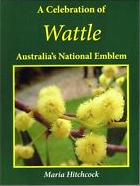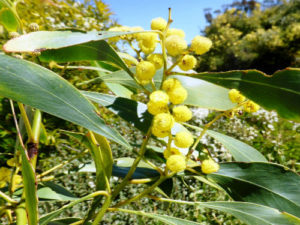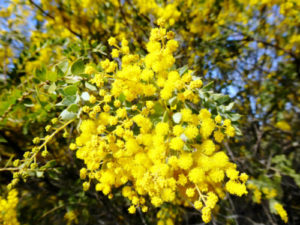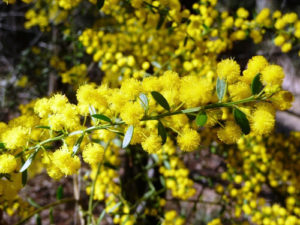The following notes are based on Maria Hitchcock’s book A Celebration of Wattle: Australia’s National Emblem (2012). The book is a revised and updated edition of Maria’s earlier book Wattle (AGPS 1991), which grew from a small booklet sent out to schools in 1988.
 Acacia or wattle?
Acacia or wattle?
Acacia is the genus name, and wattle is a common name derived from the use of Acacia saplings to build early colonial buildings in the wattle and daub method. This is a rural British building technique where flexible twigs formed a framework on which mud was daubed. Wattle is an Anglo Saxon word meaning woven.
History of Wattle Day
Wattles have always been popular because they are tough and hardy, are widespread throughout Australia, are fast growing and provide a blaze of golden colour.
But although acacias have long been used and recognised as symbols of Australia, it was only relatively recently that our national floral emblem and Wattle Day were officially recognised. Following a successful campaign by Maria Hitchcock and others, Acacia pycnantha (Golden Wattle) was gazetted as our national floral emblem in 1988 and Wattle Day was officially gazetted as 1 September in 1992.

Early in the twentieth century there was a Wattle Day League and movement to celebrate 1 September. During World War 1, in 1916 the date for wattle day in NSW was changed to 1 August because of the early blooming of wattle around Sydney. In particular, the planted Acacia baileyana, which was used for sprigs of flowers to sell for war fundraising, finished flowering by 1 September. NSW maintained the date of 1 August after the war, and the tradition of Wattle Day was kept alive in NSW in the 1920s and 1930s as school-based celebrations, but faded in other states.
Wattle Day Association

The Wattle Day Association is a community not-for profit, non-political organisation founded in 1998. It aims to raise awareness of 1 September as National Wattle Day, of Acacia pycnantha as our national floral emblem and of wattle as a unifying symbol for all Australians. It promotes National Wattle Day as a day of celebration of Australia and the Australian spirit.
Celebrate your way
Maria’s book has a whole chapter on celebrating Wattle Day plus an anthology of wattle poetry. The Wattle Day Association website also has some ideas.
- Wear a sprig of wattle
- Display a vase or collection of wattle
- Enjoy a picnic or gathering outdoors
- Plant a wattle
- Sing a wattle song, read a wattle story or wattle poetry
- Make a wattle-based art or craft piece
- Wish people Happy Wattle Day and celebrate Australia
There are also many ideas with an environmental theme for schools and community groups such as competitions, fundraising, displays and stalls.
Resources about acacias
Websites

World Wide Wattle by the Western Australian Herbarium: Worldwidewattle.com
Wattle Day Association: www.wattleday.asn.au
Acacias for gardens: See our Plant Database with trees and shrubs at www.austplants.com.au
Books
Maria Hitchcock (2012) A Celebration of Wattle: Australia’s National Emblem. Rosenberg Publishing.
Inez Armitage (1977) Acacias of New South Wales. An oldie and a goodie, with black and white drawings of about 200 species, so look for a second hand copy.
